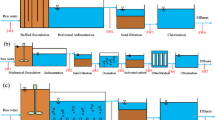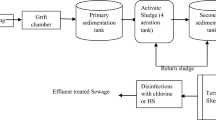Abstract
The presence of pathogenic microorganisms in public spa pools poses a serious threat to human health. The problem is particularly acute in herbal spas, in which the herbs and microorganisms may interact and produce undesirable consequences. Accordingly, the present study investigated the effectiveness of a combined disinfectant containing chlorine dioxide and sodium hypochlorite in improving the water quality of a public herbal spa in Taiwan. Water samples were collected from the spa pool and laboratory tests were then performed to measure the variation over time of the microorganism content (total CFU and total coliforms) and residual disinfectant content given a single disinfection mode (SDM) with disinfectant concentrations of 5.2 × 10, 6.29 × 10, 7.4 × 10, and 11.4 × 10−5 N, respectively. Utilizing the experience gained from the laboratory tests, a further series of on-site investigations was performed using three different disinfection modes, namely SDM, 3DM (once every 3 h disinfection mode), and 2DM (once every 2 h disinfection mode). The laboratory results showed that for all four disinfectant concentrations, the CFU concentration reduced for the first 6 h following SDM treatment, but then increased. Moreover, the ANOVA results showed that the sample treated with the highest disinfectant concentration (11.4 × 10−5 N) exhibited the lowest rate of increase in the CFU concentration. In addition, the on-site test results showed that 3DM and 2DM treatments with disinfectant concentrations in excess of 9.3 × 10 and 5.5 × 10−5 N, respectively, provided an effective reduction in the total CFU concentration. In conclusion, the experimental results presented in this study provide a useful source of reference for spa businesses seeking to improve the water quality of their spa pools.






Similar content being viewed by others
References
Barben, J., Hafen, G., & Schmid, J. (2005). Pseudomonas aeruginosa in public swimming pools and bathroom water of patients with cystic fibrosis. Journal of Cystic Fibrosis, 4, 227–231.
Brousseau, N., Lévesque, B., Guillemet, T. A., Cantin, P., Gauvin, D., Giroux, J. P., Gingras, S., Proulx, F., Côté, P. A., & Dewailly, É. (2013). Contamination of public whirlpool spas: factors associated with the presence of Legionella spp., Pseudomonas aeruginosa and Escherichia coli. International Journal of Environmental Health Research, 23, 1–15.
Catto, C., Sabrina, S., Ginette, C. T., Manuel, R., & Robert, T. (2012). Occurrence and spatial and temporal variations of disinfection by-products in the water and air of two indoor swimming pools. International Journal of Environmental Research and Public Health, 9, 2562–2586.
CDC. (2001). Prevalence of parasites in fecal material from chlorinated swimming pools—United States, 1999. Morbid Mortality Weekly Report (MMWR), 50, 410–412.
CDC. (2004). Aseptic meningitis outbreak associated with echovirus 9 among recreational vehicle campers—Connecticut, 2003. Morbid Mortality Weekly Report (MMWR), 53, 710–713.
Chu, T. S., Cheng, S. F., Wang, G. S., & Tsai, S. W. (2013). Occupational exposures of airborne trichloramine at indoor swimming pools in Taipei. Science of the Total Environment, 461–462, 317–322.
Dang, B., Chen, L., Mueller, C., Dunn, K. H., Almaguer, D., Roberts, J. L., & Otto, C. S. (2010). Ocular and respiratory symptoms among lifeguards at a hotel indoor waterpark resort. Journal of Occupational and Environmental Medicine, 52, 207–213.
Fiorillo, L., Zucker, M., Sawyer, D., & Lin, A. N. (2001). The pseudomonas hot-foot syndrome. The New England Journal of Medicine, 345, 335–338.
Gyurek, L. L., & Finch, G. R. (1998). Modeling water treatment chemical disinfection kinetics. Journal of Environmental Engineering, 124, 783–793.
Hsu, C. S., Huang, W. Z., & Wang, H. Y. (2011). Evaluation of disinfection efficiency between sodium hypochlorite and chlorine dioxide on spa water. Sustainable Environment Research, 21, 347–351.
Huang, J. L., Wang, L., Ren, N. Q., Ma, F., & Juli. (1997). Disinfection effect of chlorine dioxide bacteria in water. Water Research, 20, 115–127.
Jolley, R. L. (1985). Basic issues in water chlorination: a chemical perspective. In R. L. Jolley et al. (Eds.), In water chlorination: chemistry, environmental impact and health effects, Vol. 5 (pp. 19–38). Cheisea: Lewis Publishers, Inc.
Liang, L., & Singer, P. C. (2003). Factors influencing the formation and relative distribution of haloacetic acids and trihalomethanes in drinking water. Environmental Science and Techology, 37, 2920–2928.
Lu, M.C., Chen, C.M., Chang, A.T., Hsu, C.S. (2009). Improvement of herbal spas environmental quality with chlorine dioxide. The 3rd IWA-ASPIRE Conference & Exhibition (October, 2009).
Lumb, R., Stapledon, R., Scroop, A., Bond, P., Cunliffe, D., Goodwin, A., Doyle, R., & Bastian, I. (2004). Investigation of spa pools associated with lung disorders caused by Mycobacterium avium complex in immunocompetent adults. Applied and Environment Microbiology, 70, 4906–4910.
Plewa, M. J., Waqner, E. D., Richardson, S. D., Thruston, A. D. J., Woo, Y. T., & McKague, A. B. (2004). Chemical and biological characterization of newly discovered iodoacid drinking water disinfection byproducts. Environmental Science and Techology, 38, 4713–4722.
Reali, D., & Rosati, S. (1994). Antibiotic susceptibility and serotyping of pseudomonas aeruginosa strains isolated from surface waters, thermomineral waters and clinical specimens. International Journal of Hygiene and Environmental Medicine, 196, 75–80.
Rook, J. J. (1974). Formation of haloforms during chlorination of natural waters. Water Treatment Exam, 23, 234–243.
Taiwan EPA (2011). Class I Public Water Quality Standards, Taiwan Environmental Protection Administration, accessed November 6, 2013 at http://www.watertec.com/epa/lls.htm.
Taiwan EPA (2013). Guidelines on environmental analysis laboratory, Taiwan Environmental Protection Administration, accessed December 5, 2013 at http://www.niea.gov.tw/analysis/method/ListMethod.asp?methodtype=LIVE.
Taiwan CDC (2013). Notes on the Communicable Disease Prevention and Health Management in Business Place. Taiwan Centers for Disease Control, accessed October 24, 2013 at: http://www.cdc.gov.tw/info.aspx?treeid=5ff75185b74d8265&nowtreeid=ad7ef24470c1578a&tid=EDA1762D7E2E89E9.
Tartanson, M. A., Soussan, L., Rivallin, M., Chis, C., Penaranda, D., Lapergue, R., Calmels, P., & Faur, C. (2014). A new silver based composite material for SPA water disinfecteion. Water Research, 63, 135–146.
Tate, D., Mawer, S., & Newton, A. (2003). Outbreak of Pseudomonas aeruginosa folliculitis associated with a swimming pool inflatable. Epidemiology and Infection, 130, 187–192.
Taylor, G. R., & Butler, M. (1982). A comparison of the virucidal properties of chlorine, chlorine dioxide, bromine chloride and iodine. The Journal of Hygiene (Lond), 89, 321–328.
US EPA. (2007). Pesticides: topical & chemical fact sheets-chlorine dioxide. Washington: US Environmental Protection Agency.
Zwiener, C., Richardson, S. D., DeMarini, D. M., Grummt, T., Glauner, T., & Frimmel, F. H. (2007). Drowning in disinfection byproducts? Assessing swimming pool water. Environmental Science and Technology, 41, 363–372.
Acknowledgments
The authors would like to thank the National Science Council of the Republic of China, Taiwan, for the partial financial support provided to this study under Contract No. NSC 99-2221-E-041-015-.
Author information
Authors and Affiliations
Corresponding author
Rights and permissions
About this article
Cite this article
Hsu, CS., Huang, DJ. Disinfection of herbal spa pool using combined chlorine dioxide and sodium hypochlorite treatment. Environ Monit Assess 187, 34 (2015). https://doi.org/10.1007/s10661-014-4242-3
Received:
Accepted:
Published:
DOI: https://doi.org/10.1007/s10661-014-4242-3




